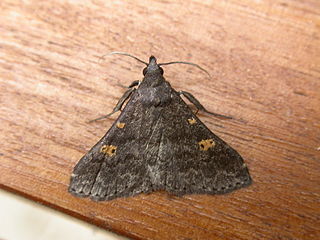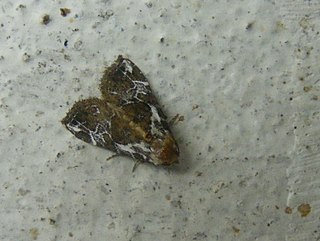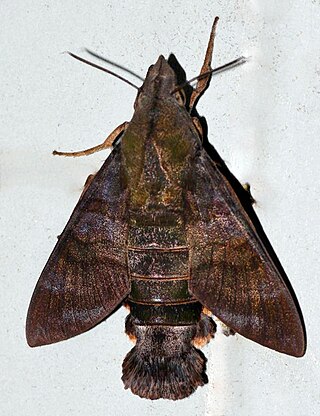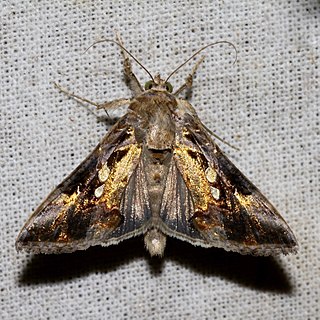
Theretra oldenlandiae, the impatiens hawkmoth, taro hornworm or white-banded hunter hawkmoth, is a member of the family Sphingidae.

Theretra latreillii, the pale brown hawk moth, is a moth of the family Sphingidae described by William Sharp Macleay in 1826. It is found in most of Asia, including Borneo, China, Hong Kong, the Philippines, Taiwan and also throughout the tropical and temperate regions of Australia.

Theretra nessus, the yam hawk moth, is a moth of the family Sphingidae. It was described by Dru Drury in 1773.

Theretra silhetensis, the brown-banded hunter hawkmoth, is a moth of the family Sphingidae described by Francis Walker in 1856. It lives in Indo-Australia, India, Sri Lanka, Papua New Guinea, East Australia, Solomon Islands, Fiji Islands, Vanuatu Islands.

Naarda is a large genus of erebid moths currently encompassing 108 species. Initially identified by Francis Walker in 1866, it is in the family Erebidae. Somewhat ruddy in appearance, this genus is distinguishable for its generally slender thorax and abdomen, and straight, porrect labial palpi. Most species are a light tan color, but shading can reach as deep as a charcoal, with muddy yellow, conspicuous reniform, orbicular stigmata featured on the forewings, sometimes reflected bilaterally superior.

Utetheisa pulchelloides, the heliotrope moth, is a moth of the family Erebidae. It is found in the Indo-Australian region including Borneo, Hong Kong, New Zealand, Papua, Seychelles, most of Australia,Tenerife and La Línea de la Concepción [Cádiz]. The species was first described by George Hampson in 1907.

Chorsia is a genus of moths of the family Erebidae. The genus was erected by Francis Walker in 1863.
Dunira is a genus of moths of the family Erebidae. The genus was erected by Frederic Moore in 1885.

Macroglossum corythus is a species of hawk moth of the family Sphingidae. It was described by Francis Walker in 1856 and is found throughout the Indo-Australian tropics east to New Caledonia.

Macroglossum divergens, the broad-bordered hummingbird hawkmoth, is a moth of the family Sphingidae. It was described by Jean Baptiste Boisduval in 1875. It is found from north-eastern Sikkim, India across southern China to Cheju Island, southern Japan, Taiwan and the Philippines and then south through Vietnam, Thailand, Malaysia and Indonesia to New Guinea and neighbouring islands. It may be in Sri Lanka.

Argyrogramma signata, the green semilooper, is a moth of the family Noctuidae.

Dysaethria is a genus of moths in the family Uraniidae. It was described by Turner in 1911. The species of this genus occur mainly in Asia and in Australia.

Dysaethria quadricaudata is a species of moth of the family Uraniidae first described by Francis Walker in 1896. It is found in the Indo-Australian tropics from India, Sri Lanka to Myanmar, Taiwan and the Solomon Islands. The habitat consists of lowland forests and disturbed and cultivated areas.

Diomea rotundata is a moth of the family Noctuidae first described by Francis Walker in 1857. It is found in Sri Lanka, the Indian subregion, Taiwan, Sumatra, Borneo, the Philippines and Sumba.
Dysaethria scopocera is a moth of the family Uraniidae first described by George Hampson in 1896. It is found in Sri Lanka, Taiwan, Malaysia and Borneo.
Metorthocheilus emarginata, or Chundana emarginata, is a moth of the family Uraniidae first described by George Hampson in 1891. It is found in the Indian subregion, Sri Lanka, Taiwan, Borneo, Java and Seram.

Pseudomicronia advocataria is a moth of the family Uraniidae first described by Francis Walker in 1861. It is found in the Philippines, Sundaland, the Andaman Islands, India, Taiwan, South China and Sri Lanka.
Phycidopsis albovittata is a moth of the family Notodontidae first described by George Hampson in 1893. It is found in Sri Lanka, India, Sundaland, Luzon in the Philippines and Sulawesi.

Rivula basalis is a moth of the family Erebidae first described by George Hampson in 1891. It is found in South India, Sri Lanka, Indo-China, Thailand, South China, Taiwan, Java, Bali and Borneo.
Grapholita dysaethria is a moth of the family Tortricidae first described by Alexey Diakonoff in 1982. It is found in Sri Lanka.

















